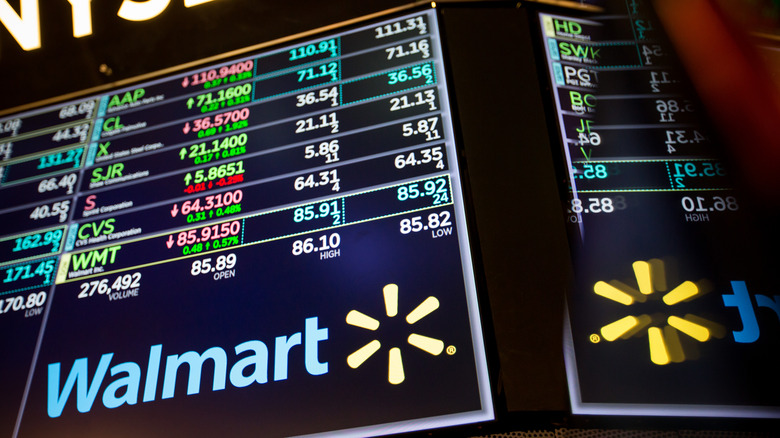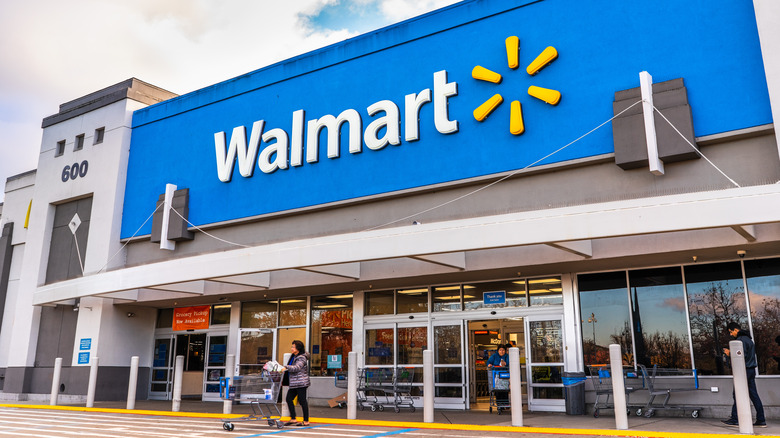Walmart's Stock Just Seriously Plummeted. Here's Why.
Walmart's stock price posted the sharpest single-day drop in 35 years this past Tuesday, after releasing an earnings report that revealed the company's net income for this quarter is down a full 25% from the same time period last year, reports CNN Business. And the trend continued yesterday, with Walmart stock sliding even further down an additional 6%, according to The Motley Fool. Walmart's stock drop reflects a larger trend in the retail industry, with Target's stock also dropping earlier this week.
Walmart has typically been viewed as a "blue chip" investment, reports Investopedia, a phrase signifying a well-established company with national name-brand recognition and sound financial practices whose goods and services are widely accepted and consumed, giving the organization the ability to ride out financial downturns. Walmart has a long record of consistent growth and remains one of the largest companies in the world, providing almost 2.2 million people with jobs and operating nearly 11,000 locations. The organization has consistently outperformed the S&P 500, a stock index fund that tracks the performance of the 500 largest companies in the United States, and has been paying out an annual dividend, or a share of its earnings, to its shareholders every year, demonstrating a consistent ability to turn a significant profit.
So, what's going on with Walmart now? While Walmart's stock slide may be temporary, it is caused in part by serious, ongoing issues in the retail space, which may be increasingly difficult for the company to overcome.
Inflation is impacting Walmart's customers
Inflation refers to rising costs of goods and services and a resulting devaluation of a currency such as the dollar, which has decreased purchasing power, per Investopedia. The U.S. Bureau of Labor Statistics reports that prices for consumer goods have gone up 8.5% from the end of March 2021 to the end of March 2022. That increase is even higher than the previous month's inflation numbers, with February's report showing a 7.9% in prices from the end of February 2021 to the end of February 2022. March's inflation report demonstrates the highest rise in prices in over forty years.
Spiking inflation is catching up to big retail chains such as Walmart. CNN Business reports that Walmart's Chief Executive Officer Doug McMillon directly attributed the decrease in the company's revenue to the increase in inflation, particularly in food and fuel costs. Walmart now has to pay more to both purchase and transport its goods, and it has passed some of that increased cost on to its shoppers. Although Walmart has been raising prices at a slower rate than some of its retail competitors, the company reports that shoppers are still spending less at its stores, particularly on discretionary purchases. Investopedia defines discretionary spending as purchases consumers can live without, such as a new TV. The combination of Walmart's customers facing economic pressure and choosing to spend money only on essentials and the pressure Walmart itself is facing with food and fuel costs is driving down the company's profits.
Walmart's COVID-related supply chain issues continue
Even when consumers choose to spend discretionary money at Walmart, they sometimes can't find the item they wanted to buy. Although retailers have come a long way from the early days of the pandemic, when Insider reported a stray roll of toilet paper was rare enough to provoke actual physical brawls between customers, shortages continue for certain goods. According to CBS News, the COVID-19 pandemic continues to block up the supply chain for items such as packaged goods, clothing, and basic tools -– staples of Walmart's inventory. Walmart is caught in a double bind: it has to pay higher prices for fewer goods, and a lack of available products may drive its customers to shop elsewhere.
The company announced on Tuesday that it was lowering its profit outlook for the year, per CNN Business. It had originally anticipated 2022 to reflect a 3% increase in overall profits, but now the organization anticipates a net loss of at least 1% by the end of the year. Investors are taking notice and running for the hills.


